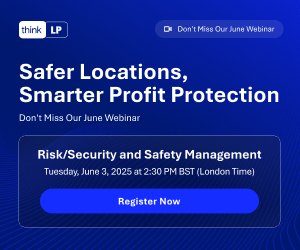Staff Safety
You Don’t Walk Away from a Forklift Truck Accident
Why LP is More than P&L, and Safety Culture is Everyone’s Responsibility
When we talk about loss prevention (LP), particularly in the retail environment, we automatically think of store detectives or security guards intervening to deter theft or detain shoplifters. But, in its wider sense, LP as interpreted by this magazine over the last decade, is a much broader church.
Indeed, the pages of Loss Prevention Magazine Europe have almost defied the world of LP, viewing it as a pseudo-science exploring the empirical, evidence based as well as the proven human and technological intervention and disruption solutions that underpin risk reduction and management beyond the everyday profit and loss (P&L) of the business.
In short, the magazine has stretched the somewhat narrow interpretation to cover the worlds of psychology and behaviours as well as incorporating the disciplines of human resources (HR) and health and safety (H&S) to prove the inextricable link and interdependence of the words “loss” and “prevention”.
It is after all the latter’s necessary influence on the former that slows or stops everyday actions or inactions, triggering a chain of causation and the all-too foreseeable reactions that can lead to catastrophic consequences and losses that are almost too extreme to countenance—the tragic human cost of avoidable loss.
Busy supply chains in an increasingly omni-channel world depend upon accuracy and agility to ensure that the right goods are in the right place at the right time and at the right price. Increased security, speed, and safety are also fundamental to the narrative of the modern pick-perfect distribution centre (DC), for example.
However, compliance can present an issue when the strict safety processes and procedures are not observed as a result of a sub-culture of corner-cutting which is often symptomatic of high-burn and high-churn industries where, fuelled by pressures such as the cost-of-living crisis and the National Living Wage, perennial staff shortages lead to recruitment and retention challenges requiring an almost constant loop of induction training.
It’s not as though the residual staff are not aware of the safety rules, but there have been all-too-regular near misses and RIDDOR requiring incidents as a result of the kind of shortcuts, and “blind-eye” behaviours that result in materials handling equipment (MHE) and people being in the wrong place at the wrong time.
Accident Statistics
According to figures from across the world including the Health and Safety Executive (HSE) in the UK, one in five workplace fatalities are caused by a forklift truck or industrial vehicle, while 1,500 injuries are directly caused by them. Three in ten of these injuries are in the transportation and storage sector, the all-important supply chain feeding the busy markets such as manufacturing, automotive, construction, and retail.
All-too-many of those accidents are avoidable as a result of KPIs driving better safety compliance, communication, and the elimination of a culture of complacency.
According to a recent survey carried out by Mentor FLT Training, one in four respondents said forklift operators at their company were either not aware of the safe systems of work (SSOW) in place or didn’t comply with them. Despite often receiving basic training, the instructors were made aware of instances of how complacency and bad habits among operators can soon lead to unsafe practice if the employer fails to identify and stop it.
According to Mentor’s managing director Stuart Taylor: “All-too-often, the safety message is lost in translation between best practice documented at senior level and what’s happening on the ground. The importance of the entire workforce always following the procedures put in place for their protection is simply not impressed upon the work team—for example, due to poor communication by managers, or a failure by managers and supervisors to regularly reinforce the forklift safety message and instructions, or to spot and correct unsafe behaviour.”
“To plug the gap, and steer complacent individuals away from bad habits and poor practice, managers and supervisors must be proactive. If they don’t take action, it can send a message to other team members that this behaviour is OK—and it doesn’t take long for these bad habits to be adopted as common practice.”
“Complacency can also potentially be influenced by an individual’s peers or the company’s safety culture. If colleagues regularly take short-cuts around the safe use of MHE, there is a culture of workers being allowed or even encouraged to take risks. As well as these possible factors, complacency may just be a natural consequence of human behaviour and how our brains work.”
The Lisa Ramos Story
This is also the dominant message of Lisa Ramos, an impact motivational speaker who “walks the talk”, albeit prosthetically, as a result of a life-changing accident where the collision of culture and complacency led to an almost fatal accident on a day that should have seen her celebrating her son becoming a teenager.
Instead, it resulted in her receiving life-altering injuries culminating in an amputation as a result of an avoidable incident involving a FLT during a shift change in a warehouse where both she and her husband Dave worked.
“Health and safety isn’t a department that sits in a silo—it is a living and breathing entity and something that we all need to understand and put into practice in our daily lives,” she said.
“What happened to me should not have happened, because the FLT driver was in a place where he should not have been—there was no reason for him to be there. The accident was down to behaviour and human error.”
It was the morning of 24 March 2006, her son Kieran’s 13th birthday. As she says in her own words:
“It was the last time I remember being completely pain free and totally at ease in my own skin and body.”
“It was supposed to be a happy day—my son was becoming a teenager, and we had a special party planned for him that night. I’d got up early to watch Kieran open his presents before going to work at my job in a warehouse where both my husband Dave and I were employed.”
“The day was uneventful and when the end of my shift rolled around at 15:30, I’d already started to look forward to the celebrations ahead.”
Lisa, a team member, was walking on a designated walkway, that was located directly in front of the container bays, when she was then struck by the 2.5 tonne reversing forklift truck.
“Looking back now I recall hearing a beeping sound that caused me to glance back over my left shoulder which I think saved my life. The next thing I know I was on the ground having been knocked down by the truck. I was screaming out in agony for the driver to get off me.”
“He shunted forward just as the other shop floor lads came running over to try and help. They assured me that I had just dislocated my knee and I believed them. I was fighting back the tears despite the excruciating pain.”
“They called Dave and an ambulance, and I remember him rushing in and cradling my head and crying which was odd despite my obvious agony, because I had never seen my husband cry.”
“All I could think about in that moment was the fact that we’d probably have to cancel Kieran’s birthday party and how disappointed he would be. I had no idea that it was the last day I would ever work with that group of lads who’d tried so desperately to keep the true extent of my injuries from me—injuries that would cause them flashbacks in the future and the requirement of counselling themselves.”
Surgery and the Aftermath
In hospital in a miasma of pain and medication, the surgeon broke the news to her that they would have to amputate her foot which she believed was the “worst case scenario”.
Only four days later the same surgeon had to remove her leg. Coming round from that operation resulted in her having flashbacks of re-living the accident.
“I’d never heard of phantom limb pain which is when the brain relives the experience over and over and over again in a perpetual nightmare, where the only relief comes in the form of even stronger painkillers,” she continued.
Faced with a life and body changing experience, the sight of what remained of her lower half made her physically sick and she developed a body “loathing” that she could not control, as well as a total loss of dignity, as the independent, outgoing, and sociable woman who loved to dance was suddenly totally reliant upon those around her which “stripped away” her dignity.
Longer term, the impact of the accident left her angry and even aggressive as she was taking up to forty painkillers each day. Skin grafts left her in constant pain, and she had to learn to walk on a prosthetic leg.
“This was the darkest period of my life, a time when I really wished I had been killed on that day. My relationship with Dave changed as he became my carer, but the worst consequence of the accident was the impact on Kieran.”
“I was totally consumed with self-pity and rage about what happened to me. I lost sight of all focus on my son. Left to his own devices and with Dave having to care for me, his behaviour began to deteriorate and eventually changed the course of his life.”
Lisa underwent eight operations, the last one of which was to try and resolve the ongoing “phantom limb” pain, but while improving the appearance of her “stump” the procedure caused other traumas. She developed OCD and PTSD and in the eighteen years since the accident, she has had to come to terms with the “new normal” of living as an amputee and feeling more comfortable in her own skin.
“It’s taken years to come to terms with what happened to me. I still suffer from debilitating pain and a lack of energy to do all the things I want to. I’ve taken tens of thousands of tablets since my accident, which could eventually take their toll on my internal organs, but it’s the chance I’m willing to take to achieve a level of relief in order to live my life.”
“It may sound daft, but one of the things I miss most since my accident is dancing. I used to love to dance the night away and I was always one of the first on the dance floor and the last one to leave it. That feeling of freedom and total abandonment is gone. But don’t get me wrong, I can still make it to the dance floor, but these days I have to be carried there,” added the tenacious Lisa.
Fines and Costs
The case came to court two years after the accident where Lisa’s employer, international distribution firm NYK Logistics (UK) Ltd, was fined £20,000.
The company, based in Northampton, was also ordered to pay £5,941 costs after admitting breaches of the Workplace (Health, Safety and Welfare) Regulations 1992 at Derby Crown Court. Undisclosed compensation was also later awarded, enabling Lisa to start to move forward with her life.
Andrew Turner, the Health and Safety Executive’s principal inspector for Derbyshire, said: “Although the company had identified that pedestrians were at risk from moving vehicles, and taken some steps to try to minimise this risk, it had become commonplace for pedestrians to walk through areas where forklift trucks maneuvered and reversed.”
“This incident could have been avoided if NYK had taken a few simple measures such as ensuring Ms Ramos’ duties didn’t involve her having to walk across a vehicle loading area or putting barriers in place to prevent pedestrian access.”
David Urpeth from law firm Irwin Mitchell said: “This was a horrific but easily avoided work accident.”
“It is no good for employers identifying risks if they fail to then protect employees from those risks. In such circumstances the result will be an industrial accident.”
Motivational Impact Speaker
The family moved to a more accessible and wheelchair-friendly bungalow near Mansfield, Nottinghamshire and she used the fire in her belly to become a motivational impact speaker and consultant to businesses and the materials handling sector.
She is an expert speaker on the subject of safety culture with her no-nonsense, “tell it like it is” approach, winning her praise and plaudits across the circuit where she puts the issue of safety culture in busy sectors front and centre in order to make sure it is high on the corporate agenda for those in the audience.
ORIS Forums
Lisa, who presented at the ORIS Forums 2024 Risk Summit at the
Old Thorns Hotel & Resort in Liphook, Hampshire attended by LP and health and safety practitioners last month (May) takes an unflinching approach to her injury. It is her honesty and ultimately her own involvement in what happened to her, that helps deliver her powerful safety culture message.
“When I think back, I was blaming the driver for not looking where he was going. It was only when I started looking at other things and asking questions like “was I working safely and doing things properly?” that made me re-appraise the situation.”
“Now I know I was equally guilty of cutting corners right, left, and centre. At the time I would have recognised ways of saving time like everyone else. Health and safety was the responsibility of the health and safety department, but now I know it is everyone’s responsibility.”
“There are still businesses where there is plenty of training, but because of high churn there are people promoted into roles where they are supervisors over people they used to work with. There is also a widespread culture of not reporting near misses. If you can’t see a stack or a wall that’s been damaged by a forklift, how can you see a person who might be in the way?”
“It’s human nature to try and find quicker ways to do things, and if you don’t have a background in risk assessments you would not necessarily see anything wrong in that approach. Looking back, I put myself in that position because I did not see the danger.”
Lisa’s Mum
Lisa’s proud mother Linda recognises the loss that she has experienced and the ongoing day-to-day battles.
“I hated it when she used to fall over and she had to struggle doing everyday things like trying on clothes in a shop, not to mention how the accident impacted our grandson,” she said.
“As a parent, it doesn’t matter if your child is two or twenty-two—when they hurt themselves you help them get back on their feet. The worry, stress, and even guilt that stems from not being able to make it all better can take its toll on a parent as we struggled to support her in any way we could.”
It is not just her love for her daughter, but her own background that adds credence to Lisa’s story. With forty years’ retail experience working in DC’s with FLTs, Linda adds: “health and safety is so important—it makes such a difference.”
Now retired from her role at Dunelm, Linda has praised the record of her former employer where health and safety is high on the corporate agenda.
Dunelm
The soft furnishings giant which has a people-centric approach to risk has grown rapidly both organically and through acquisitions, and has worked hard to deliver safer working environments across its estate to the point of removing FLTs from the rear of all of its 184 stores over the last four years, a move that has not only reduced foreseeable accidents but also reduced tens-of-thousands of pounds in costs, damage, and insurance claims.
At its Stoke DC, the business has rolled-out automatic pallet loading trucks to avoid the risk to colleagues and is introducing artificial intelligence (AI) technology in the DCs which automatically slow the FLT driver down in areas where pedestrians are located and when operating in limited visibility parts of the warehouses.
“It picks up the fact that there is a human being in close proximity, raises an alarm in the cab and automatically slows the vehicle down ahead of driver reaction,” said John Rimmer, head of health and safety, insurance, and environment at Dunelm.
“This is the biggest step forward in FLT safety because it causes the trucks to slow down in locations such as door access areas which are notoriously challenging for all warehouses.”
“We see a future where we consult widely to see where risk can be reduced further—safety is a constant challenge. We work in a fast-moving industry which is why safety has to come first.”
Loss prevention in its broadest sense deals with foreseeing and reducing risk in its manifold forms, but it is also about the salutary lessons learnt from when loss has occurred. It is not simply the missing stock or cash from the till resulting in enhanced technology and colleague or security guard interventions, but the human cost of behaviour-driven risk where prevention policies sitting in a dusty dossier do little to counter complacency and a culture of corner cutting.
Retail is a dynamic and ever-evolving environment where removing one risk may create another unforeseen one. Lisa’s salutary story is proof that fast-moving industries require perpetual and dynamic risk assessments to make sure that LP is recognised beyond P&L.






